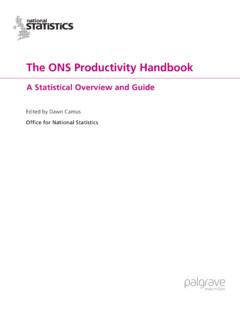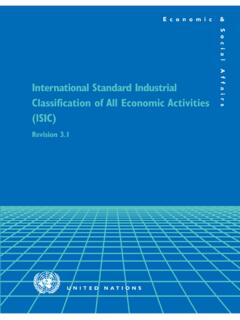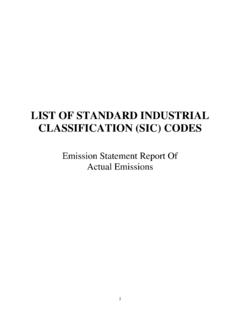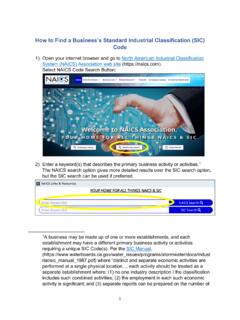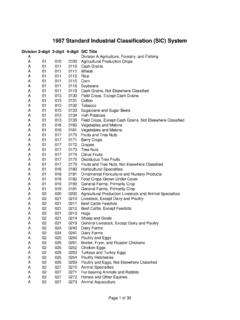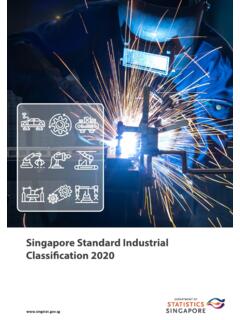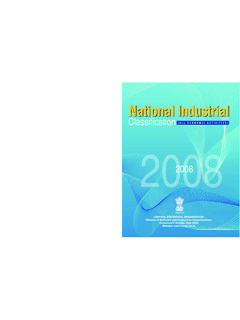Transcription of UK Standard Industrial Classification of Economic ...
1 UK Standard Industrial Classification of Economic Activities 2007 (SIC 2007)Structure and explanatory notesEditor: Lindsay Prosser Office for National StatisticsISBN 978-0-230-21012-7A National Statistics publicationNational Statistics are produced to high professional standards as set out in the Code of Practice for Official Statistics. They are produced free from political usThe Office for National Statistics The Office for National Statistics (ONS) is the executive office of the UK Statistics Authority, a non-ministerial department which reports directly to Parliament. ONS is the UK government s single largest statistical producer. It compiles information about the UK s society and economy, and provides the evidence-base for policy and decision-making, the allocation of resources, and public accountability. The Director-General of ONS reports directly to the National Statistician who is the Authority s Chief Executive and the Head of the Government Statistical Government Statistical Service The Government Statistical Service (GSS)
2 Is a network of professional statisticians and their staff operating both within the Office for National Statistics and across more than 30 other government departments and Macmillan This publication first published 2009 by Palgrave Macmillan in the UK is an imprint of Macmillan Publishers Limited, registered in England, company number 785998, of Houndmills, Basingstoke, Hampshire RG21 Macmillan in the US is a division of St Martin s Press LLC, 175 Fifth Avenue, New York, NY Macmillan is the global academic imprint of the above companies and has companies and representatives throughout the and Macmillan are registered trademarks in the United States, the United Kingdom, Europe and other countries. A catalogue record for this book is available from the British 9 8 7 6 5 4 3 2 1 18 17 16 15 14 13 12 11 10 09 ContactsThis publicationFor information about the content of this publication, contact the Editor Tel: 01329 444189 Email: customer enquiriesONS Customer Contact Centre Tel: 0845 601 3034 International: +44 (0)845 601 3034 Minicom: 01633 812399 Email: Fax: 01633 652747 Post: Room 1015, Government Buildings, Cardiff Road, Newport, South Wales NP10 8XG enquiriesTel: 0845 604 1858 Email: ordersTo obtain the print version of this publication, contact Palgrave Macmillan Tel: 01256 302611 Price.
3 And reproduction Crown copyright 2009 Published with the permission of the Office of Public Sector Information (OPSI)You may use this publication (excluding logos) free of charge in any format for research, private study or internal circulation within an organisation providing it is used accurately and not in a misleading context. The material must be acknowledged as Crown copyright and you must give the title of the source publication. Where we have identified any third party copyright material you will need to obtain permission from the copyright holders re-use of this material you must apply for a Click-Use Public Sector Information (PSI) Licence from:Office of Public Sector Information, Crown Copyright Licensing and Public Sector Information, Kew, Richmond, Surrey TW9 4DU Tel: 020 8876 3444 book is printed on paper suitable for recycling and made from fully managed and sustained forest sources.
4 Logging, pulping and manufacturing processes are expected to conform to the environmental regulations of the country of and bound in Great Britain by Hobbs the Printer Ltd, Totton, SouthamptonTypeset by Academic + Technical Typesetting, BristolContentsiii PagePreface ivIntroductionClassification changes 1 International classifications 1EC regulation 1UK SIC structure 1 Links to international classifications 2 Changes from SIC (2003) to SIC (2007) 2 Changes in the structure 2 Correspondence tables: scope and use 4 Related classifications 4 Use of the UK SIC (2007) 5UK SIC (2007) Indexes 5 References 5 Rules for classifying statistical units 7 Summary of structure 27 Explanatory notes 55 PrefaceThis publication represents a major revision of the UK Standard Industrial Classification of Economic Activities (SIC), commenced in 2002 and completed in 2007.
5 It is effective from 1 January 2008 and is the outcome of a series of consultations carried out in conjunction with a major revision of the European Union s Industrial Classification system, NACE (NACE Rev. 2).The consultations involved many stakeholders: the national statistical institutes of all EU member states the European Commission In the UK, a range of government departments, the Bank of England, the devolved administrations, business and trade associations and other interested bodies European business and trade associationsThe UK is required by European legislation to revise the SIC in parallel with NACE so that both systems remain identical down to and including the four digit class level. A further breakdown is provided for certain classes by the addition of a five digit subclass level. Both the UK SIC (2007) and NACE Rev.
6 2 are completely consistent with the fourth revision of the UN s International Standard Industrial Classification of all Economic Activities (ISIC Rev. 4).These revisions are motivated by the need to adapt the classifications to changes in the world economy. The revised classifications reflect the growing importance of service activities in the economy over the last 15 years, mainly due to the developments in information and communication technologies (ICT).The advance copy of the UK SIC (2007) structure and explanatory notes published on the website on 29 January 2007 has undergone minor revision and forms the main part of this for National StatisticsClassifications and Harmonisation UnitSegensworth RoadTitchfieldFarehamHampshirePO15 5 RRClassifications HelpdeskTel: 01329 444970 Email: 2009 IntroductionA Standard Industrial Classification (SIC) was first introduced into the UK in 1948 for use in classifying business establishments and other statistical units by the type of Economic activity in which they are engaged.
7 The Classification provides a framework for the collection, tabulation, presentation and analysis of data, and its use promotes uniformity. In addition, it can be used for administrative purposes and by non-government bodies as a convenient way of classifying Industrial activities into a common changesSince 1948 the Classification has been revised in 1958, 1968, 1980, 1992, 1997, and 2003. Revision is necessary because, over a period of time, new products and new industries to produce them emerge, and shifts of emphasis occur in existing industries. It is not always possible for the system to accommodate such developments and, after a period of time, updating the Classification is the most sensible action. The 1997 and 2003 changes were not full-scale revisions but responses to user demand for additional detail at the subclass level together with some minor renumbering and revisions.
8 This latest publication is a major revision reflecting contemporaneous changes in NACE (see next paragraph).The need for change equally effects all international classifications and they are revised from time to time to bring them up to date. On 9 October 1990 the European Council of Ministers passed a regulation to introduce a new statistical Classification of Economic activities in the European Communities (NACE Rev. 1). In January 2003, a minor revision of NACE Rev. 1, NACE Rev. , was published1 followed by a major revision, NACE Rev. 2, effective from 1 January classificationsFrom the outset, the UK SIC followed the same broad principles as the relevant international systems. UK statisticians played an important part in the formulation of the first ISIC (International Standard Industrial Classification of All Economic Activities), issued by the United Nations in 1948 and revised in 1958, 1968, 1989, 2003 and now in 2008.
9 Nevertheless, there were differences in detail between the two as ISIC reflected the structure of Economic activity in the world as a whole rather than that in one particular 1980, one of the principal objectives of the revision of the SIC was to examine and eliminate differences from the activity Classification issued by the Statistical Office of the European Communities (Eurostat) and entitled Nomenclature g n rale des activit s conomiques dans les Communaut s europ ennes, usually abbreviated to NACE. This 1970 NACE could be rearranged to agree with ISIC at aggregated levels but departed from it in the details. The 1980 revision of the SIC applied NACE as closely as was practicable to the structure of British 1990, however, the first revision of NACE was made by EC regulation and this presented a different set of regulationA European Community regulation is directly applicable in all member states.
10 It does not have to be confirmed by national parliaments in order to have binding effect. The NACE regulation, therefore, made it obligatory on the UK to introduce a new Standard Industrial Classification , SIC (92), based on NACE Rev. 1, and to use it where the UK is required to transmit to the European Commission statistics on Economic NACE regulation gives effect to the wish of Eurostat to establish a common statistical Classification of Economic activities in order to promote comparability between national and Community classifications and, therefore, between national and Community statistics. The regulation applies to the use of NACE for statistical purposes only, although a country can also use NACE for administrative purposes. The regulation does not oblige member states to collect, publish or supply data. NACE is only a language and all requests for data collection, transmission and publication must be specified elsewhere.

